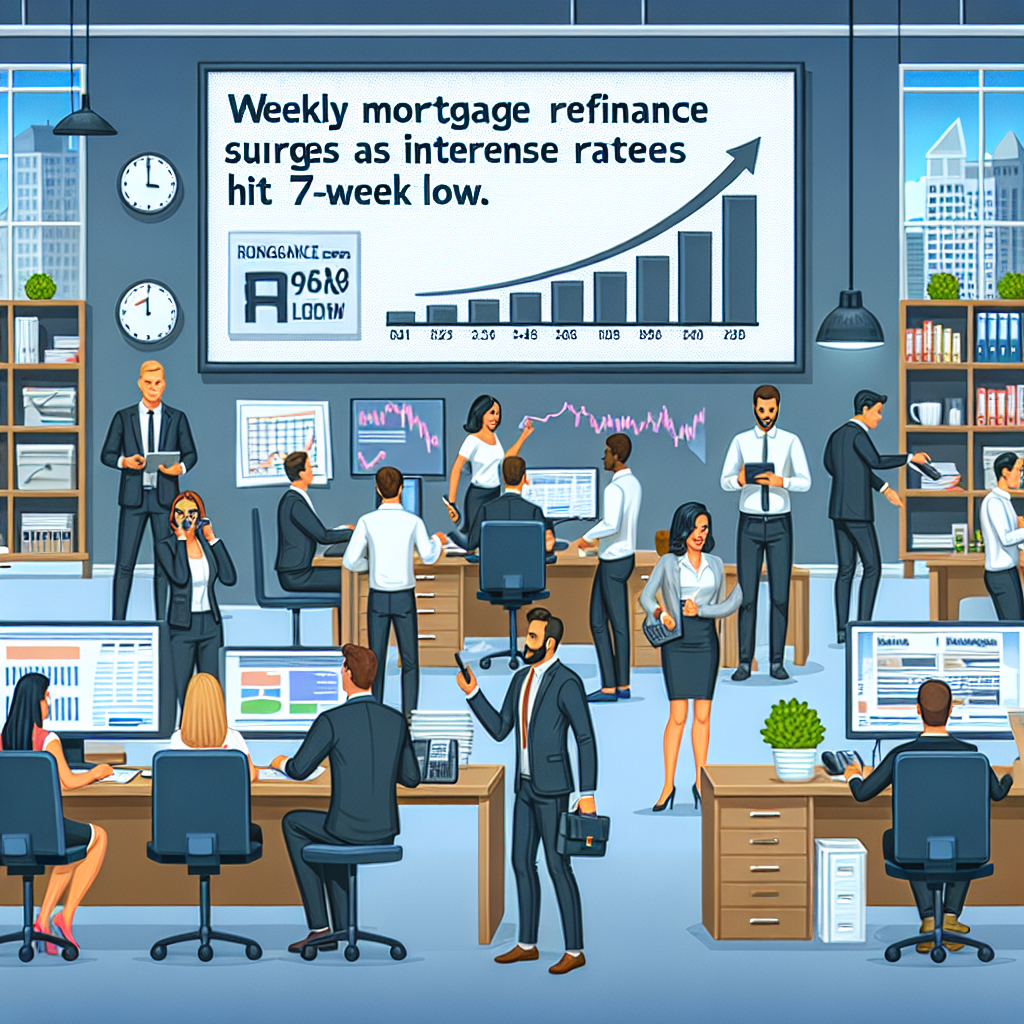-
Table of Contents
- Weekly Mortgage Refinance Demand Surges as Interest Rates Hit 7-Week Low
- Understanding the Current Mortgage Landscape
- Factors Contributing to Lower Interest Rates
- The Surge in Mortgage Refinance Demand
- Benefits of Refinancing
- Case Study: A Homeowner’s Refinance Journey
- Implications for the Broader Economy
- Impact on Lenders
- Real Estate Market Dynamics
- Consumer Spending and Economic Growth
- Challenges and Considerations
- Potential Risks for Homeowners
- Regulatory and Policy Considerations
- Conclusion
Weekly Mortgage Refinance Demand Surges as Interest Rates Hit 7-Week Low

The mortgage market is experiencing a significant shift as interest rates hit a seven-week low, leading to a surge in weekly mortgage refinance demand. This article delves into the factors driving this trend, the implications for homeowners and the broader economy, and provides valuable insights supported by relevant examples, case studies, and statistics.
Understanding the Current Mortgage Landscape
In recent weeks, the mortgage market has seen a notable decline in interest rates, reaching levels not observed in the past seven weeks. This drop has sparked a wave of refinancing activity among homeowners looking to take advantage of the lower rates. To understand the full impact of this trend, it’s essential to explore the underlying factors contributing to the current mortgage landscape.
Factors Contributing to Lower Interest Rates
Several key factors have contributed to the recent decline in mortgage interest rates:
- Economic Uncertainty: Ongoing economic uncertainty, including concerns about inflation and potential recessions, has led to fluctuations in interest rates. Investors often seek safer investments, such as government bonds, which can drive down mortgage rates.
- Federal Reserve Policies: The Federal Reserve’s monetary policies, including adjustments to the federal funds rate and bond-buying programs, play a significant role in influencing mortgage rates. Recent actions by the Fed have contributed to the current low-rate environment.
- Global Market Trends: Global economic trends and geopolitical events can also impact mortgage rates. For example, international trade tensions or changes in foreign central bank policies can create ripple effects in the U.S. mortgage market.
The Surge in Mortgage Refinance Demand
As interest rates hit a seven-week low, homeowners are seizing the opportunity to refinance their mortgages. This surge in demand is driven by several compelling reasons:
Benefits of Refinancing
Refinancing a mortgage can offer numerous benefits to homeowners, including:
- Lower Monthly Payments: By securing a lower interest rate, homeowners can reduce their monthly mortgage payments, freeing up cash for other expenses or savings.
- Shorter Loan Terms: Some homeowners opt to refinance into shorter loan terms, such as moving from a 30-year to a 15-year mortgage, allowing them to pay off their homes faster and save on interest over the life of the loan.
- Access to Home Equity: Cash-out refinancing allows homeowners to tap into their home equity for major expenses, such as home improvements, education, or debt consolidation.
Case Study: A Homeowner’s Refinance Journey
Consider the case of John and Mary Smith, a couple who purchased their home five years ago with a 30-year fixed-rate mortgage at 4.5%. With interest rates now at a seven-week low, they decided to refinance their mortgage. By securing a new 30-year fixed-rate mortgage at 3.0%, they were able to reduce their monthly payments by $200. Additionally, they opted for a cash-out refinance, allowing them to access $20,000 in home equity to fund a kitchen renovation. This case study illustrates how refinancing can provide both immediate and long-term financial benefits.
Implications for the Broader Economy
The surge in mortgage refinance demand has broader implications for the economy, affecting various stakeholders, including lenders, real estate markets, and consumers.
Impact on Lenders
Lenders are experiencing increased activity as homeowners rush to refinance their mortgages. This surge in demand can lead to:
- Higher Loan Volumes: Lenders benefit from higher loan volumes, which can boost their revenue and profitability.
- Operational Challenges: The increased demand may strain lenders’ operational capacities, leading to longer processing times and potential delays in closing loans.
- Competitive Pressure: Lenders may face competitive pressure to offer attractive rates and terms to capture a larger share of the refinancing market.
Real Estate Market Dynamics
The real estate market is also influenced by the surge in mortgage refinance demand:
- Increased Home Sales: Lower interest rates can make homeownership more affordable, potentially leading to increased home sales and higher demand for real estate.
- Home Price Appreciation: As demand for homes rises, home prices may appreciate, benefiting current homeowners but potentially creating affordability challenges for new buyers.
- Housing Inventory: The availability of housing inventory can impact the market dynamics. A shortage of homes for sale may drive up prices, while an oversupply can lead to price stabilization.
Consumer Spending and Economic Growth
The broader economy can benefit from increased consumer spending resulting from lower mortgage payments:
- Increased Disposable Income: Homeowners with lower monthly mortgage payments have more disposable income to spend on goods and services, stimulating economic growth.
- Debt Reduction: Some homeowners use the savings from refinancing to pay down high-interest debt, improving their financial stability and reducing overall debt levels.
- Investment Opportunities: Lower mortgage payments can free up funds for investments in other areas, such as retirement accounts, education, or small businesses.
Challenges and Considerations
While the surge in mortgage refinance demand presents numerous opportunities, there are also challenges and considerations that homeowners and stakeholders should be aware of.
Potential Risks for Homeowners
Homeowners considering refinancing should carefully evaluate potential risks:
- Closing Costs: Refinancing typically involves closing costs, which can range from 2% to 5% of the loan amount. Homeowners should ensure that the long-term savings outweigh these upfront costs.
- Extended Loan Terms: Refinancing into a new 30-year mortgage can extend the loan term, potentially resulting in higher overall interest payments over the life of the loan.
- Market Fluctuations: Interest rates can fluctuate, and homeowners should be prepared for potential changes in the market that could impact their refinancing plans.
Regulatory and Policy Considerations
Regulatory and policy factors can also influence the mortgage refinance landscape:
- Government Programs: Government programs, such as the Home Affordable Refinance Program (HARP), can provide additional refinancing options for eligible homeowners.
- Regulatory Changes: Changes in mortgage regulations and lending standards can impact the availability and terms of refinancing options.
- Tax Implications: Homeowners should consider the tax implications of refinancing, including potential changes to mortgage interest deductions.
Conclusion
The recent decline in mortgage interest rates to a seven-week low has sparked a surge in weekly mortgage refinance demand. Homeowners are taking advantage of the opportunity to secure lower rates, reduce monthly payments, and access home equity. This trend has significant implications for lenders, the real estate market, and the broader economy, driving increased loan volumes, home sales, and consumer spending.
However, homeowners should carefully evaluate the potential risks and costs associated with refinancing, including closing costs, extended loan terms, and market fluctuations. Additionally, regulatory and policy factors can influence the refinancing landscape, and homeowners should stay informed about relevant programs and changes.
In summary, the current low-rate environment presents a valuable opportunity for homeowners to improve their financial positions through refinancing. By understanding the benefits, challenges, and broader implications, homeowners can make informed decisions that align with their long-term financial goals.








